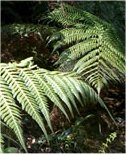Bracken is a common native perennial plant found usually on hills and moorland. It spreads by black horizontal rhizomes deep in the soil to forms large patches. The triangular bladed leaves grow 1m - 1.5m feet tall on good sites. Spores produced in late summer.

Weight loss, weakness, gait abnormalities - staggering (bracken staggers), lack of coordination, muscle tremors. Early in the course of the poisoning a slow heart rate and abnormalities of the heart rhythm changing to increase in heartbeat and temperature. after mild exercise. If untreated and the poisoning runs its course death occurs within 2 to 10 days of the onset of signs.
Notes:
The whole plant contains toxins which remain active if the plant
is cut and dried while in its green state. The roots are said
to be five times more poisonous than the fronds and care should
be taken if ploughing or digging land on which bracken is growing.
Poisoning can occur at any time of year, but is more likely in
the late summer between August and October when other sources
of forage are scarce. Bracken is not considered palatable to
horses, but they will eat it if no other forage is available.
Care should be taken it is not in hay or bedding.